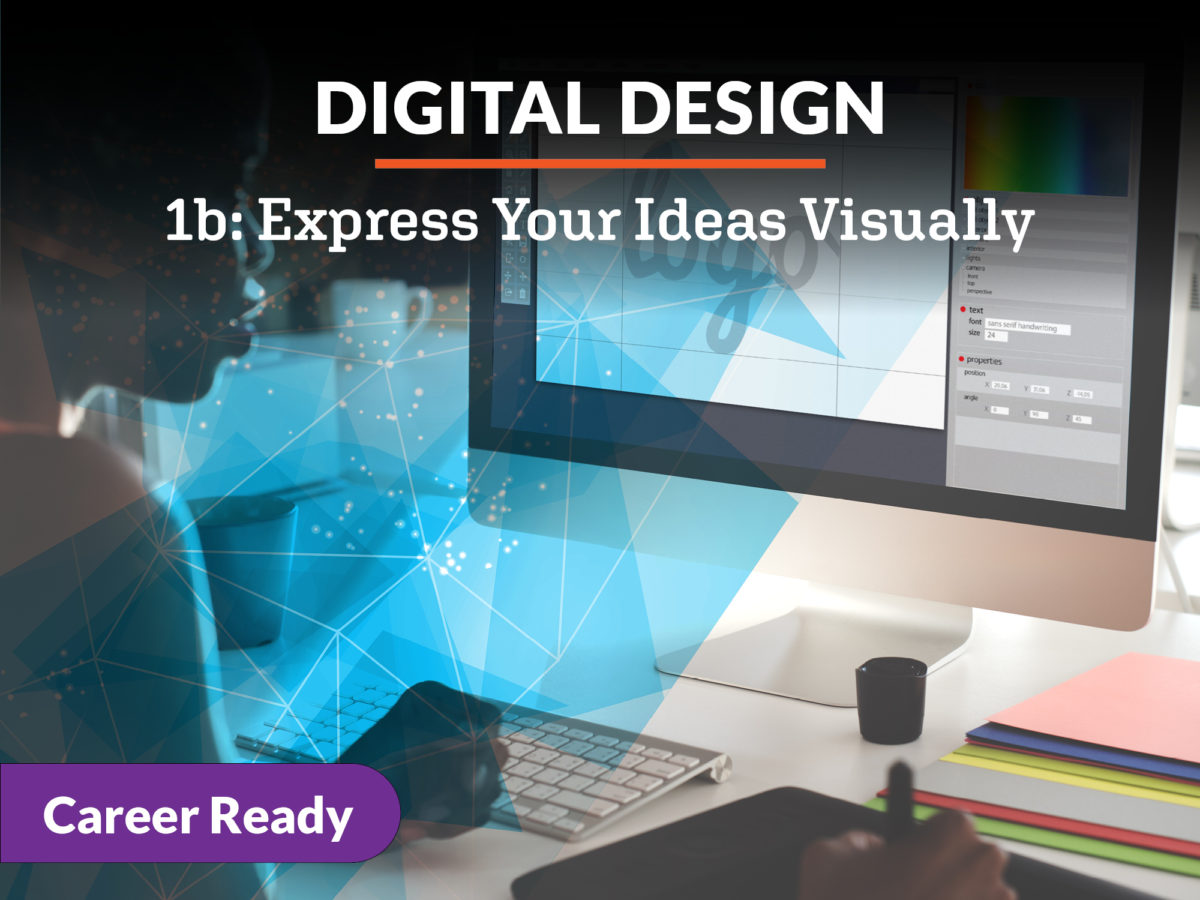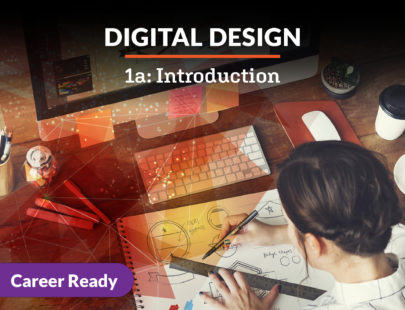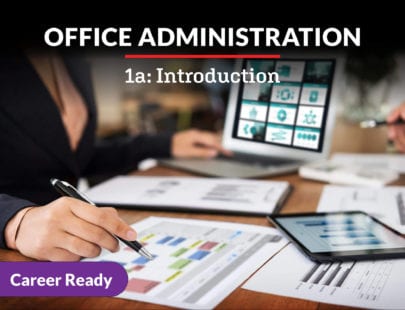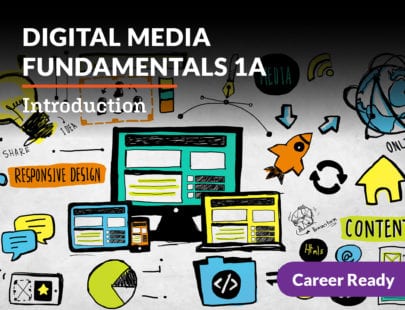
Digital Design 1b: Express Your Ideas Visually
Are you ready to dig deeper and discover more about the world of digital design? In this course, you will continue building the foundational skills necessary to become a successful graphic designer. You will learn and apply effective communication and people skills, explore and implement the design process, create images, properly use equipment, and evaluate and market your own designs. By the end of the course, you’ll better be able to decide if a career in digital design is for you… and if the answer is yes, you’ll be well on your way to designing a bright future!
Units at a Glance
Unit 1: Effective Communication Skills
For a graphic designer, as in all professional careers, an ability to communicate with others is a crucial skill. Graphic designers begin each project by listening to and conversing with colleagues, supervisors, and clients to determine the specifications for the designs they’ll be creating. During production, they regularly communicate with clients and coworkers to make sure the project is on track and delivering according to plan. In order to communicate effectively, graphic designers should practice active listening, have a learning mindset during conversations, and know how to ask the right kinds of questions. In addition, it’s important to understand cultural differences in communication practices and to use critical thinking to work with the team to solve any problems and challenges that surface.
What will you learn in this unit?
- Define and practice the stages of active listening
- Describe the mindset necessary to be an effective oral communicator
- Apply critical thinking and problem-solving skills to business communications
Unit 2: The Design Process
Effective graphic design projects aren’t created in a day—they require planning and a process. The bigger the project, the more important the process becomes, often with project managers who make sure everyone on the team knows their responsibilities, deadlines, and budgets. Even if you’re working on a small project and you’re the only team member, it’s still advisable to organize your design development process to include pre-production, production, and post-production activities.
What will you learn in this unit?
- Describe how project management skills are employed in the planning stage of a design project
- Apply appropriate production practices based on the output of a design project
- Demonstrate evaluation skills during the post-production phase of a design project
Unit 3: Using Images
Sometimes every element in a design is something original that you created, but other times you will need to incorporate digital images, photographs, animation, or video that was created by someone else. When using “found” images and other digital elements, it’s important to understand the ethics of intellectual property so you don’t misuse someone’s work unethically or illegally. It’s also important to understand file types and formats so that you can be sure to import the best one for the design you’re creating. Once you’ve found an image or an element to add to your design, you can use graphics software to revise it and then export it for distribution.
What will you learn in this unit?
- Demonstrate an understanding of the basic image file formats and how to use them in graphic design
- Explain the ethical and legal issues related to the use of intellectual property
- Describe how to import, revise, and incorporate digital images into a graphic design and then export them in an appropriate format for distribution
Unit 4: Creating Images
Along with using found images, graphic designers also create and revise their own digital images, combine images, and become expert at using graphics software to revise and manipulate several types of image formats. They use the principles of composition to create effective images with a clear purpose that guide viewers’ eyes and tell a story, and then further enhance the images using raster or vector graphics software. Software has also made it possible for designers to easily animate designs that will be distributed online.
What will you learn in this unit?
- Design and conduct a photoshoot to create raster images and edit them using graphics software
- Use vector-based software to design, create, and revise simple illustrations
- Explain the basic uses of animation in graphic design and create simple animation files
Unit 5: Effective People Skills
To manage a successful graphic design business, you’ll have to become an expert at working with design and also an expert at working with people. Depending on whether you’re running your own business, working within a design firm, or working in the marketing or design department of an organization, you’ll need to know something about how to maintain effective public relations, how to handle client relationships in a crisis situation, how to foster teamwork, how to handle conflict on a team, and how to enhance your leadership skills. You can’t do the graphic design business alone—it’s a group effort. In this unit, we’ll consider the many relationships you’ll foster and benefit from as a designer.
What will you learn in this unit?
- Understand the importance of public relations in the graphic design business, including effective crisis management
- Explain the necessity of team-building and conflict-management skills in the graphic design workplace
- Describe and practice mentoring and leadership skills
Unit 6: Using Equipment Effectively
As a graphic designer, the most important piece of equipment in your toolbox is you. That’s why it’s important to learn how to practice self-care, especially when it comes to how you work within your office or home workspace. You also need to take care of the computer and electronic equipment that allow you to do the work of graphic design. Sometimes you’ll be using highly specialized equipment like high-end, graphics-enabled computer setups or expensive cameras, lenses, filters, and lighting systems, and sometimes you’ll just be using your phone. You can learn the right mindset now about how to value and care for the tools of your trade.
What will you learn in this unit?
- Understand key ergonomic principles for working on a computer, including how to achieve neutral posture
- Properly care for and use computer and electronic equipment
- Troubleshoot and maintain your computer and electronic equipment
Unit 7: Creating a Safe Environment
It’s a wild world out there—you need a safe place in which to work. If you’re working for a company, they’re required by governmental laws and regulations to provide a safe workplace. If you’re working from home, it’s up to you to maintain safety standards and preparation. A safe environment is the result of preparation and planning for both physical and virtual safety. In the physical world, maintain safe work practices and always be prepared in case of emergencies. In the online world, cyber security can have a significant impact on both you and the company you work for.
What will you learn in this unit?
- Demonstrate an understanding of cyber safety and ethical online practices
- Describe and apply appropriate workplace safety practices
- Identify procedures to be followed in emergency situations
Unit 8: Marketing and Presenting Your Graphic Design Work
Whether you want to work on the team of a large design firm or you’d rather strike out on your own and work as a freelance designer, it’s important to apply the basic principles of marketing to your design career. There are three important ways to market and display your work to current and prospective clients: by maintaining a web presence design portfolio, marketing to make connections with users via social media, and giving live presentations with visual accompaniment. These marketing projects are just as important as the work you create as a designer because it doesn’t matter how great your work is or how advanced your skills are if no one knows about them. The good news is that you can start practicing how to market your work now.
What will you learn in this unit?
- Analyze how to best use social media for marketing your personal brand
- Create a design portfolio
- Deliver effective presentations of your work
Required Materials
Physical
- Audio recording device
- Digital camera
- Paper and pens
Software
- Word processing software
- Presentation software
- Website building and hosting platform
- Vector editing software
- Raster-based editing software
Optional
- Video recording device




